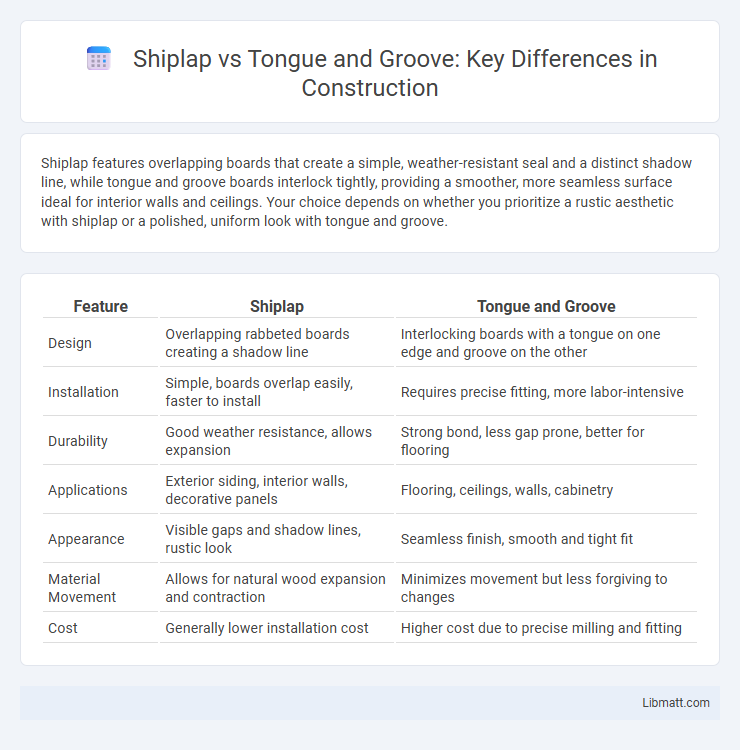Shiplap features overlapping boards that create a simple, weather-resistant seal and a distinct shadow line, while tongue and groove boards interlock tightly, providing a smoother, more seamless surface ideal for interior walls and ceilings. Your choice depends on whether you prioritize a rustic aesthetic with shiplap or a polished, uniform look with tongue and groove.
Table of Comparison
| Feature | Shiplap | Tongue and Groove |
|---|---|---|
| Design | Overlapping rabbeted boards creating a shadow line | Interlocking boards with a tongue on one edge and groove on the other |
| Installation | Simple, boards overlap easily, faster to install | Requires precise fitting, more labor-intensive |
| Durability | Good weather resistance, allows expansion | Strong bond, less gap prone, better for flooring |
| Applications | Exterior siding, interior walls, decorative panels | Flooring, ceilings, walls, cabinetry |
| Appearance | Visible gaps and shadow lines, rustic look | Seamless finish, smooth and tight fit |
| Material Movement | Allows for natural wood expansion and contraction | Minimizes movement but less forgiving to changes |
| Cost | Generally lower installation cost | Higher cost due to precise milling and fitting |
Introduction: Shiplap vs Tongue and Groove
Shiplap and tongue and groove are popular wood paneling options known for their distinct installation methods and aesthetic appeal. Shiplap features overlapping boards with a rabbet joint creating a flat, weather-resistant surface, making it ideal for rustic, farmhouse styles. Tongue and groove panels interlock via a protruding tongue fitting into a corresponding groove, providing a tight, seamless finish preferred in traditional and modern interior designs.
Appearance and Visual Differences
Shiplap boards feature a slight gap between each panel, creating distinct shadow lines that add texture and depth to walls, while tongue and groove panels fit tightly together, producing a seamless and smooth surface ideal for a sleek, refined look. Shiplap typically displays a more rustic or farmhouse aesthetic due to its overlapping edges, whereas tongue and groove offers a cleaner, more uniform appearance favored in modern and traditional interiors. Both options enhance wall detail, but the choice depends on whether a pronounced pattern or a subtle finish is desired.
Installation Methods Compared
Shiplap installation involves overlapping boards with a rabbet joint that creates a tight, weather-resistant seal, making it ideal for exterior applications and simple to install with basic tools. Tongue and groove boards interlock via a protruding tongue that fits into a corresponding groove, providing a seamless, flush surface commonly used for interior walls and ceilings, requiring precise alignment and possibly professional skill for optimal results. Both methods offer sturdy construction, but shiplap allows quicker installation with minimal adjustments while tongue and groove provides superior stability and finish quality under careful installation.
Material and Cost Considerations
Shiplap and tongue and groove boards are commonly made from wood, pine being a cost-effective option that suits various budgets. Shiplap features a rabbeted edge for overlapping installation, often reducing material waste and labor costs, while tongue and groove boards interlock tightly, providing superior durability but sometimes at a higher price due to more precise milling. Your choice between the two should consider the balance between upfront material costs and the desired finished look, as well as long-term performance.
Durability and Longevity
Shiplap and tongue and groove both offer strong durability, but tongue and groove joints create a tighter, more weather-resistant seal ideal for areas exposed to moisture. Shiplap's overlapping design allows for natural wood expansion and contraction, making it less prone to warping over time. Tongue and groove typically provides greater structural integrity in flooring and wall applications, enhancing overall longevity when properly installed and maintained.
Maintenance Requirements
Shiplap requires less maintenance due to its simple overlapping design, which allows for natural expansion and contraction without causing damage. Tongue and groove joints fit tightly and can be prone to moisture buildup, leading to potential warping or mold issues that may require more frequent upkeep. Your choice affects maintenance ease, with shiplap being a more forgiving option in varying environmental conditions.
Best Applications for Each Option
Shiplap is best suited for interior walls and ceilings where a rustic or farmhouse aesthetic is desired, offering easy installation with overlapping edges that prevent moisture penetration. Tongue and groove provides a tighter fit ideal for flooring, exterior siding, and ceilings requiring a more polished, seamless finish with enhanced stability. Your choice depends on whether you prioritize decorative appeal and weather resistance or a refined, flush surface with superior structural integrity.
Insulation and Weather Resistance
Shiplap boards feature a rabbet joint that allows for slight gaps, which can reduce insulation effectiveness but improves ventilation, making it suitable for dry climates. Tongue and groove panels interlock tightly, providing superior weather resistance and insulation by minimizing air infiltration and moisture penetration. Both materials benefit from proper sealing and installation to enhance thermal performance and durability against weather elements.
Design Versatility and Aesthetics
Shiplap offers a clean, modern look with its overlapping boards creating subtle shadow lines, ideal for both rustic farmhouses and contemporary interiors. Tongue and groove panels provide a seamless, tight fit that enhances a smooth surface, lending itself well to traditional, craftsman, or elegant design styles. Both options allow for various finishes and paint colors, maximizing customization to suit diverse aesthetic preferences and architectural themes.
Choosing the Right Wall Paneling for Your Space
Selecting between shiplap and tongue and groove wall paneling depends on the desired aesthetic and functional requirements of your space. Shiplap offers a distinctive, horizontal overlapping design that creates a clean, rustic look while providing excellent weather resistance and ease of installation. Tongue and groove panels interlock tightly, offering a smooth, seamless surface ideal for a polished, traditional finish that enhances insulation and durability.
Shiplap vs tongue and groove Infographic

 libmatt.com
libmatt.com